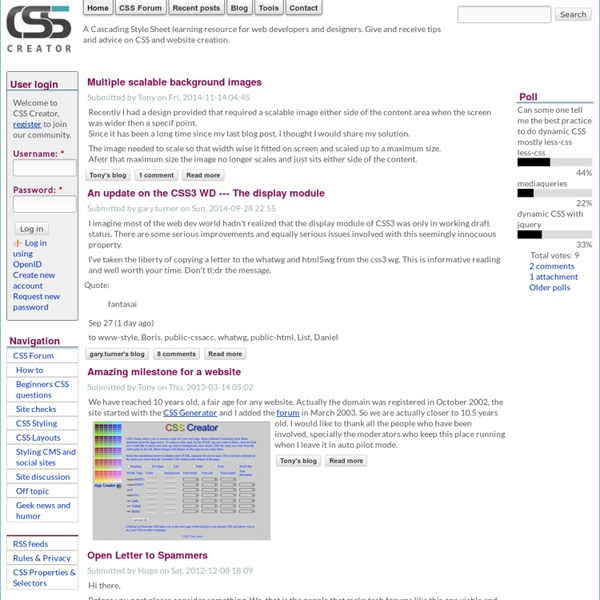



The 30 CSS Selectors you Must Memorize So you learned the base id, class, and descendant selectors—and then called it a day? If so, you're missing out on an enormous level of flexibility. While many of the selectors mentioned in this article are part of the CSS3 spec, and are, consequently, only available in modern browsers, you owe it to yourself to commit these to memory. And by the way, if you're having trouble with your CSS and want a pro to look over it and fix any errors, you can find some qualified freelancers on Envato Studio. Let's knock the obvious ones out, for the beginners, before we move onto the more advanced selectors. The star symbol will target every single element on the page.
CSS3 technology in action: Design examples Ryan Boudreaux highlights some beautiful examples of CSS3 design projects by some individuals who are at the forefront in tinkering with the new code possibilities. While CSS3 and HTML5 technologies are still fresh for most organizations, there are many trend-setting web developers who are taking the new tools by storm. This post will highlight several examples which utilize the full potential of CSS3 in delivering excellence in design, look, and feel. The first group includes several projects and experiments by individuals tinkering with CSS3. You can also view the examples below in a gallery format here.
13 Really Useful Online CSS Tools to Streamline Development CSS is nearly used on every modern website design. However, having to write and structure CSS code from scratch every time you have a project is extremely time consuming. Below, we present you with 13 amazingly useful CSS tools for hacking on writing time consuming code. We tried to place emphasis on unknown tools that every developer should have a looksy at, however don’t be surprised if we included a few known sources. We encourage you to find use of these tools and find ways to improve your development process. Pragmatic, practical font sizing in CSS One thing I’ve been thinking a lot about lately is how to build sites properly. Not what we have been told is proper, but what actually makes sense for us as developers. I recently spoke at The Digital Barn on exactly this; my talk—Breaking Good Habits—dealt with how we as developers need to solve problems not only for our users and clients, but for ourselves as well. Nicole Sullivan has laid a lot of new foundations for us in her work on OOCSS and her ‘unconventional’ but absolutely spot-on approach to building websites.
CSS Beginner Tutorial CSS, or Cascading Styles Sheets, is a way to style and present HTML. Whereas the HTML is the meaning or content, the style sheet is the presentation of that document. Styles don’t smell or taste anything like HTML, they have a format of ‘property: value’ and most properties can be applied to most HTML tags. Applying CSS - The different ways you can apply CSS to HTML.Selectors, Properties, and Values - The bits that make up CSS.Colors - How to use color.Text - How to manipulate the size and shape of text.Margins and Padding - How to space things out.Borders - Erm. Borders. Things that go around things.Putting It All Together - Throwing all of the above ingredients into one spicy hotpot.
CSS Gradients for IE9 « CSS3 Wizardry This works with Desktop IE9, Desktop Firefox, Desktop Chrome, Desktop Safari, Desktop Opera, iOS, and Android. Attention! IE9 will not destroy the world, kill babies, or take away your home or job. Simply put, IE9 is the best browser Microsoft has ever released. Graph Paper About This 8.5 x 11 inch graph paper is made for visual designers, interaction designers, and information architects. You'll find styles for wireframing user interfaces, and story boarding interaction.
designyourway I used to ignore CSS generators because I thought that there isn’t any use for them. This happened before CSS3 when I didn’t need a generator to create something, however with the gaining popularity that CSS3 had, I had to move towards it and start learning it to adapt to the new standards as most web designers did. These are very interesting tools which can help you a lot when wanting to learn CSS3 faster.
The CSS Box Model At the risk of over-repeating myself: every element in web design is a rectangular box. This was my ah-ha moment that helped me really start to understand CSS-based web design and accomplish the layouts I wanted to accomplish. We've talked about the positioning of these boxes a bit, and about their behavior. Try out the CSS 3 Template Layout module @Buguletzu – I’m interested to hear why you feel that makes it unusable. Most enhancement scripts (i.e. JS rounded corner generators) don’t run until the DOM is loaded, do you feel they’re unusable too?
Snazzy Hover Effects Using CSS With all these CSS3 effects and tutorials popping up every day that show all the new and wonderful things we can make happen, we sometimes forget about poor little old CSS2.1 and the great potential it still has. With very good browser support, we can do lots of cool things that we know will work in all major browsers. In this tutorial, I will be going over creating flexible advanced hover techniques using CSS2.1 properties. Here is a live demonstration of the effect we will be creating. Advanced hover states are quite simple When I first started learning CSS, the :hover pseudo-element was no more than a way to remove the underline on a text link.
Current page higlighting with CSS This is a basic test page. You can read the article here. First we'll set up our navigation list. I have chosen 4 sections for ease, and its best if navigation sections are kept short anyway: <ul id="navlist"><li><a href="index.html" >Home</a></li><li><a href="products.html">Products</a></li><li><a href="faq.html">FAQ</a></li><li><a href="contact.html">contact us</a></li></ul>